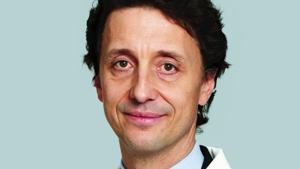Dr. Roach: Case of hot flashes has yet to be resolved, despite therapy

DEAR DR. ROACH: I am 78 years old. I had a hysterectomy in 1976 due to excessive vaginal bleeding, but I still have my ovaries. I have had hot flashes since undergoing menopause — they usually last three to five minutes, and I have them about every two hours around the clock (which obviously interferes with my sleep).
Over the last 28 years, I have tried Premarin (which gave me bad headaches), gabapentin, venlafaxine, Bellergal, melatonin, black cohosh, clonidine, DHEA, Pro-Gest cream (chamomile, hops and valerian), progesterone and estrogen (together), avoiding caffeine and eliminating dairy products. None of these has helped.
ANSWER: I’m sorry to hear of your difficulties. You have certainly tried about all the available therapies.
There are two additional ones you might want to consider: Megesterol is a hormonal therapy that is helpful for some women, but the fact that you haven’t responded to estrogens and progestins is not promising. The other is called a stellate ganglion block. You can ask your physician about it.
People are also reading…
DEAR DR. ROACH: Why are older patients always asked, “Have you ever fallen?” It is annoying, and I wish you would stop asking.
ANSWER: Falls in older adults are a major cause of disability. Falls can lead to fractures, and fractures lead to poor movement.
A history of a fall is a major risk for future falls, so any person with a history of indoor falls should undergo a pretty comprehensive evaluation as to why they fell and to see what can be done to prevent future falls. This includes, of course, managing any chronic illness, but also correcting vision as much as possible; evaluating the home for risks such as poor lighting and area rugs; and evaluating gait and balance, with a referral to a physical therapist for exercises to improve these and for assistive devices, if necessary.
Falls may also be the first indication of a significant medical or neurological condition that may benefit from treatment.
DEAR DR. ROACH: After a patient has had megadoses of IV and oral antibiotics, is there anything they should do to restore the balance in their bodies, such as eating probiotics or yogurt, or is that just all nonsense?
ANSWER: The idea makes perfect sense: Antibiotics not only kill the bad bacteria that is infecting us, they also kill many of the healthy bacteria that help us with digestion and other functions. (The whole suite of healthy bacteria living in our gut is termed the “microbiome.”) Why not help the gut return to normal by giving it some healthy bacteria, such as those found in yogurt with live cultures, or specific probiotics, which are just the healthy bacteria?
The answer is that it has been very hard to prove that there is any benefit in doing so. In people with no symptoms after finishing an antibiotic course, there probably aren’t any benefits. At least one study showed what researchers called a “very severe disturbance” in the person’s microbiome and actually slowed the return to a person’s normal microbiome, which they had prior to antibiotics. Worse still, very rarely, infections have been transmitted through probiotics.
Symptoms after antibiotic therapy, especially diarrhea and fever, could indicate a very severe infection called Closteroides dificile (“C. diff”), which does not respond to probiotics and usually needs powerful antibiotics to treat.
Email questions to [email protected]
For all the latest Health News Click Here
For the latest news and updates, follow us on Google News.
